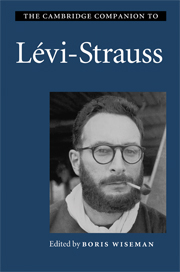Book contents
- Frontmatter
- Introduction
- Part I: Society and culture
- Part II: Myth and mind
- 5 The two natures of Lévi-Strauss
- 6 On anthropological knowledge
- 7 The limits of classification: Claude Lévi-Strauss and Mary Douglas
- 8 The local and the universal
- 9 Lévi-Strauss and the question of symbolism
- 10 Claude Lévi-Strauss’s theoretical and actual approaches to myth
- Part III: Language and alterity
- Part IV: Literature and aesthetics
- Bibliography of works by Claude Lévi-Strauss
- Index
6 - On anthropological knowledge
from Part II: - Myth and mind
Published online by Cambridge University Press: 28 January 2010
- Frontmatter
- Introduction
- Part I: Society and culture
- Part II: Myth and mind
- 5 The two natures of Lévi-Strauss
- 6 On anthropological knowledge
- 7 The limits of classification: Claude Lévi-Strauss and Mary Douglas
- 8 The local and the universal
- 9 Lévi-Strauss and the question of symbolism
- 10 Claude Lévi-Strauss’s theoretical and actual approaches to myth
- Part III: Language and alterity
- Part IV: Literature and aesthetics
- Bibliography of works by Claude Lévi-Strauss
- Index
Summary
It was in the fifties that Lévi-Strauss explicitly focused on anthropological knowledge, at a decisive moment indeed. A deep, to many readers troubling, difference opposes The Elementary Structures of Kinship (1949a; 1969a) to a series of later, connected books beginning with The Savage Mind (1962b; 1966b). It testified to a completely new approach to ethnographic understanding. Lévi-Strauss himself confirmed the break. In between, ten years had passed, devoted to an epistemological reflection, echoed in homages paid to Mauss, Durkheim and Rousseau. Lévi-Strauss had definitely turned to a question first raised by Mauss, who left it unanswered, standing as a sealed legacy. When Lévi-Strauss came back from New York, he might have decided either to start new fieldwork in the Pacific or to pursue his theoretical research, turning to some non-elementary structures of kinship. These would have supplied a link of sorts to confront contemporary social constructions of family relations in post-war Western societies. Although he never forgot his concern for civil life, he finally chose a third option, precisely to reconsider anthropological knowledge as such.
Three enigmas surfaced out of his preceding experiences. One is closely bound to structuralism, another to his Brazilian fieldwork and the third to Mauss's limited success in The Gift. All have to do with the very possibility of anthropology as a science. The uncontested achievement of The Elementary Structures of Kinship (1949a; 1969a) had come at an excessively high price. To confirm his argument and give it a decisive perspicuity, Lévi-Strauss resorted to a mathematical representation, a specific application of group theory supplied by the mathematician André Weil.
- Type
- Chapter
- Information
- The Cambridge Companion to Lévi-Strauss , pp. 118 - 138Publisher: Cambridge University PressPrint publication year: 2009
- 2
- Cited by



